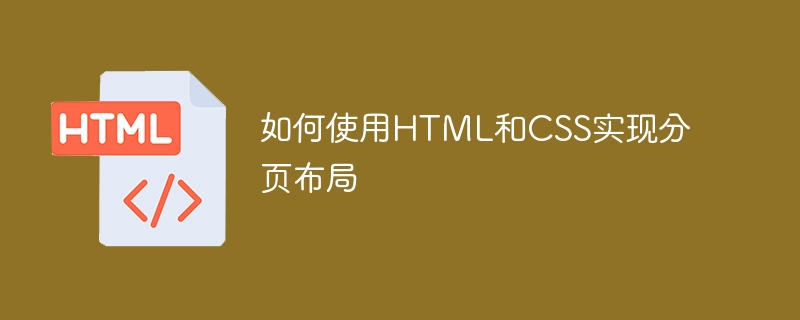

How to use HTML and CSS to implement paging layout
In modern web design, paging layout is a common way to display a large amount of content in groups and provide Simple and clear navigation. This article will use HTML and CSS as the basis to introduce how to implement a simple and practical paging layout, and attach specific code examples.
<!DOCTYPE html>
<html>
<head>
<title>分页布局示例</title>
<link rel="stylesheet" type="text/css" href="styles.css">
</head>
<body>
<header>
<!-- 头部内容 -->
</header>
<main>
<!-- 内容区域 -->
</main>
<footer>
<!-- 页脚内容 -->
</footer>
</body>
</html>* {
margin: 0;
padding: 0;
box-sizing: border-box;
}
body {
font-family: Arial, sans-serif;
line-height: 1.5;
}
header {
background-color: #333;
color: #fff;
padding: 20px;
}
main {
padding: 20px;
}
footer {
background-color: #333;
color: #fff;
padding: 20px;
text-align: center;
}The above code defines the basic style of the page. The header and footer have the same background color and style, and the content area has certain padding.
<main>
<div class="pagination">
<a href="#" class="active">1</a>
<a href="#">2</a>
<a href="#">3</a>
<a href="#">4</a>
<a href="#">5</a>
</div>
</main>The above code defines a container that contains five pagination tags. The first tag sets an .active class to represent the current page number, which can be added and modified as needed.
Next, we need to define the style of .container and each paging tag in it. You can use the following code as a starting point:
.pagination {
display: flex;
justify-content: center;
align-items: center;
margin-top: 20px;
}
.pagination a {
display: block;
padding: 10px;
margin: 0 5px;
border: 1px solid #333;
color: #333;
text-decoration: none;
transition: background-color 0.3s ease;
}
.pagination a.active {
background-color: #333;
color: #fff;
}The above code defines the style of the .pagination class, using flex layout to display the pagination label horizontally and centered. Each pagination label has a certain inner margin, outer margin, and border color. is #333, and the text color in the inactive state is also #333.
In order to distinguish the current page number label from other labels, we also define the style of the .active class, with the background color being #333 and the text color being #fff.
Through the above code, we have completed a simple and practical paging layout. You can fine-tune the style and expand the functionality as needed.
Conclusion
This article shows you how to use HTML and CSS to implement a simple and practical paging layout through specific code examples. I hope it will be helpful to everyone in web design and coding. At the same time, we also hope that everyone can further optimize and expand according to their own needs.
The above is the detailed content of How to implement pagination layout using HTML and CSS. For more information, please follow other related articles on the PHP Chinese website!